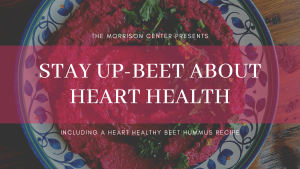
Red beetroot is one of the first things that comes to mind whenever we say, “eat the rainbow”– and for good reason!
Beets Can Promote Circulation
This vibrant, deep-red root vegetable contains a substance called inorganic nitrate, which has been studied extensively for its effects on the cardiovascular system when reduced to nitric oxide.[1] Nitric oxide (NO) is a vasodilator, meaning it dilates blood vessels. In doing so, it can lower blood pressure and improve circulation in the body.[2] With increased nitrate levels and circulation, we can experience improved endurance and performance.* You can find dietary nitrates in leafy green vegetables and, you guessed it, BEETS!
The Color Does More Than Look Pretty
Red beetroot is called a superfood for a reason. Not only does it contain a significant amount of nitrates, but it also has tons of antioxidants that carry anti-inflammatory and detoxifying properties. The vibrant red color is mostly due to a pigment group called betalains, which have been shown to protect cells against oxidative damage.[3]
They’re Great for the Gut
Did you know that beets also contain a great deal of glutamine? Another reason why it’s an awesome superfood! Glutamine is a conditionally essential amino acid that serves a vital role in gut repair and the synthesis of glutathione, our body’s master antioxidant.*
How to Eat More Beets
As with many other vegetables, beets in their raw form provide maximum nutrition benefits. However, we know that not everyone is able to eat raw veggies, and that’s totally fine! You can still steam, roast, boil, and even pickle them. Just be mindful that the longer they cook, the more likely that the nutrient levels decrease. Below is a recipe that could use either cooked or raw beets to make a beautiful hummus.
Beet Hummus
Ingredients
- 1 large beet, peeled & diced into small chunks
- 1.5 cups chickpeas, boiled and drained
- 2 cloves garlic
- 2 tbsp tahini
- 2-3 tbsp lemon juice
- 2 tbsp cold-pressed, extra virgin olive oil
- salt and pepper to taste
- 1 tbsp cold-pressed, extra virgin olive oil for plating
- (Optional) Garnish with: lemon zest, microgreens, chopped nuts, sunflower seeds, or minced herbs (i.e. parsley, cilantro, mint)
Directions
- Blend beets, chickpeas, garlic, tahini, and lemon juice in a food processor or blender until smooth.
- Drizzle in olive oil as the mixture is still blending. If the hummus is too thick for your liking, add more olive oil a little at a time.
- Adjust taste with additional lemon juice and seasonings to your preference.
- Transfer hummus to a plate or bowl and drizzle 1 tbsp olive oil on top.
- Garnish with toppings of your choice.
Looking for a beet supplement?
We recommend neo40 by HumanN, which contains 425 mg of a nitric oxide blend per lozenge. The professional formula is designed to improve circulation and blood pressure by supporting nitric oxide production in the body.*
Looking for more advice about heart healthy foods?
Our team of integrative practitioners is happy to help you identify the most suitable foods and supplements to support your health. Call our office to find out more: 212-989-9828.
*These statements have not been evaluated by the FDA and are not intended to treat or cure any disease.
References
- McNally B, Griffin JL, Roberts LD. Dietary inorganic nitrate: from villain to hero in metabolic disease? Mol Nutr Food Res. 2016;60(1):67-78. doi:10.1002/mnfr.201500153
- Hoffman DJ. Use of beetroot juice extract for hypertension treatment in low- and middle-income countries. J Nutr. 2020;150(9):2233-2234. https://doi.org/10.1093/jn/nxaa215
- Clifford T, Howatson G, West DJ, Stevenson EJ. The potential benefits of red beetroot supplementation in health and disease. Nutrients. 2015;7(4):2801-2822. doi:10.3390/nu7042801